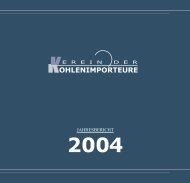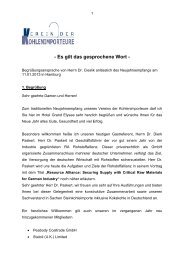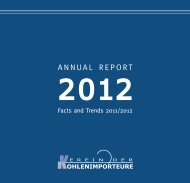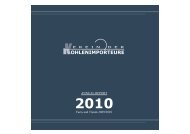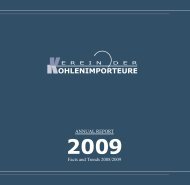Annual Report 2010 - Verein der Kohlenimporteure eV
Annual Report 2010 - Verein der Kohlenimporteure eV
Annual Report 2010 - Verein der Kohlenimporteure eV
You also want an ePaper? Increase the reach of your titles
YUMPU automatically turns print PDFs into web optimized ePapers that Google loves.
80<br />
Port capacity is available for additional exports in the<br />
event of a rise in demand and production. Thun<strong>der</strong> Bay<br />
Terminal, with a capacity of 11-12 Mtpa, is used for the<br />
inland shipment of Canadian coal to the USA over the<br />
Great Lakes.<br />
Exports<br />
Seaborne exports of 33 Mt break down into about 6 Mt<br />
<br />
went overland to the USA, mostly coking coal.<br />
The increase in exports came to 5 Mt, boosted by<br />
demand from China and Japan. China purchased 0.5<br />
Mt more coking coal and an additional 0.6 Mt of steam<br />
coal. Japan’s increase amounted to 2 Mt of coking coal.<br />
There is a chance that Canada’s export situation will<br />
further improve in 2011 if the steel industry continues<br />
to recover and also if it can cover any shortfall in<br />
production in Australia.<br />
The import demands of India and China will be of<br />
decisive importance for the long-term development of<br />
Canadian exports.<br />
Key Figures Canada<br />
2008<br />
Mt<br />
2009<br />
Mt<br />
<strong>2010</strong><br />
Mt<br />
Hard Coal Output 38 28 33<br />
Hard Coal Exports 33 28 33<br />
Steam Coal 6 6 6<br />
Coking Coal 27 22 27<br />
Imports to Germany 1.7 1.1 1.2<br />
Coking Coal 1.7 1.1 1.2<br />
Export Rate in %<br />
LB-T32<br />
87 100 100<br />
VIETNAM<br />
Production<br />
<br />
Domestic consumption went from 18 Mt to 23.3 Mt.<br />
Most output is anthracite, although small quantities of<br />
lignite and sub-bituminous coal are also mined. The<br />
latter are used exclusively for domestic consumption,<br />
while the anthracite output goes largely for export.<br />
The output capacities of Vietnamese mines, at 64.5<br />
Mtpa, based on information from the state-owned<br />
Vinacom (2006), were clearly over-estimated.<br />
Otherwise, these capacities would continue to be well<br />
un<strong>der</strong> utilised.<br />
According to state plans, production is to be slightly<br />
increased by 1-3 million tonnes per annum between<br />
2011 and 2015 and then to 55 million tonnes in 2015.<br />
This is at odds with the request of the Vietnamese<br />
Ministry for Planning and Investment to only produce<br />
44 million tonnes in 2011.<br />
Vietnam’s fast-growing economy could trigger an<br />
increase in import demand for steam coal. However,<br />
Vietnam was also hit by the economic crisis in 2009 and<br />
GDP contracted. Nonetheless, in the mid-term – from<br />
2013 – Vietnam could become a significant importer<br />
of steam coal and reduce its exports because of higher<br />
local demand.<br />
Infrastructure<br />
The waters on the eastern coast of Vietnam are mostly<br />
shallow and have in the past allowed access only to ships<br />
of less than 10,000 DWT. In Cam Pha, larger ships can<br />
now be loaded following dredging. And it is possible to<br />
also handle 65,000 DWT ships with additional loading<br />
in the roads. Hon Gai-Port can handle 10,000 DWT<br />
ships at the pier and 30,000 DWT ships in the roads.<br />
The first deep-water port is planned to be constructed<br />
in central Vietnam.



